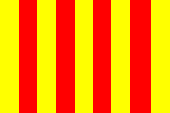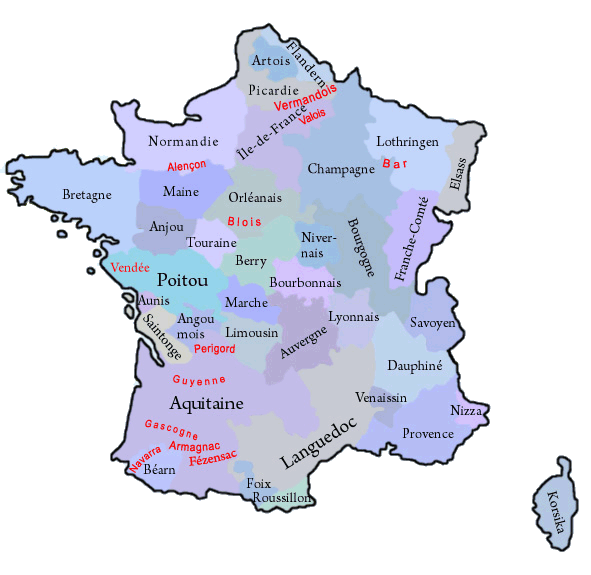mobile View, to the German Version tap the flag


- Roussillon, Catalan: Rosselló
- historical region in today's France
- former county and province
• Flag
• Meaning/Origin of the Flag
• Coat of Arms
• Meaning/Origin of the Coat of Arms
• Map of the historical Regions in France
• Explanations about the Regions
• History
• Origin of the Country's Name

Flag of Roussillon
– drapeau de Roussillon,
Source, by: Die Welt der Flaggen




The flag of Roussillon shows the image of the arms of the County of Roussillon, like it was in use from the 11th century.
Source:
Volker Preuß


since ca. 1100,
Coat of arms of Roussillon
– blason de Roussillon,
Source, by:
heraldique.org

878–1173, Bellonids,
Coat of arms of the House of the Bellonids
– blason de Maison du Bellonide,
Source, by:
Wikipedia (FR)

1276–1344,
Coat of arms of the Kingdom of Majorca
– blason de du Royaume de Majorque,
Source, by:
Wikipedia (EN)

1344–1461,
Coat of arms of the House of the Bellonids
– blason de Maison du Bellonide,
Source, by:
Wikipedia (FR)

1461–1493, Valois,
Coat of arms of the House of Valois
– blason de Maison du Valois,
Source, by:
Wikipedia (EN)

1493–1479,
Coat of arms of the House of the Bellonids
– blason de Maison du Bellonide,
Source, by:
Wikipedia (FR)

1641–1789, de Bourbon,
Coat of arms of the House of Bourbon
– blason de Maison du Bourbon,
Source, by:
Wikipedia (D)

That coat of arms, which is today known as the coat of arms of Roussillon, is very old. It goes back to the first counts out of the House of the Bellonids, which ruled – with one break – the country from the 9th to the 15th century. It shows four vertical red bars on gold. The Belloniden have been the first Counts of Carcassonne and Empúries, later Counts of Barcelona and became even the Kings of Majorca and Aragon, and also the Counts of Roussillon. The first coat of arms of that design was handed out about 875 by the west-frankish king Carl the Bald to Wilfried the Hairy (Guifré el Pilós), the Count of Barcelona, because he showed great courage in the fights against the Moors (Arabs). After the legend the blazon arised as a fighter draws its bloody fingers of its hand through the hitherto valid coat of arms of the count. The coat of arms of the County of Barcelona shows four red bars on golden ground. It has its origin in an older coat of arms which showed four red disks on golden ground. This goes back to Wilfried the Hairy and symbolizes the by him united counties of Urgell, Cerdanya, Barcelona and Girona. But Count Raimund Berengar III. of Barcelona wrote down a completely different interpretation of his coat of arms which says the following: The coat of arms is red and shows three golden bars. They stand for the three columns of power in the County of Barcelona, namely Barcelona itself, the Place of Besalú and the Place of Provenca. Possibly has the since 1263 by Aragon used naval flag its roots in this interpretation. This image of the coat of arms was taken over in the coats of arms of some French kings as the successors in the rule over the county.
Source:
heraldique.org,
Volker Preuß

The historical, French Regions:

in black: governorate and province in 1776,
in red: former county, province oder governorate
Map: Volker Preuß

The until the French Revolution existing provinces (or governorates) have been historically grown structures, which had their roots oftenly in former fiefdoms of the French crown, historic counties and duchies. They oftenly existed for hundreds of years and had preserved regionality (e.g. cultural particularities and regional languages). On the occasion of the French Revolution such phenomena were of course not desirable, and as part of their bloody and violent egalitarianism any regional references were eliminated. Shortly after the French Revolution the provinces were dissolved and France became divided into many départements, which should have approximately the same size and the same status. The départements were named after rivers or mountains, to use never and in no circumstances the name of an old province. However, there was no success in cutting the connections of the people of France to their respective regions, so that administrative regions were re-created in 1960, to have a better control in regional administrative processes. In this way became départements, which were placed in a historical province, administratively grouped to an oftenly historically named region. The resulted structures coincide only approximately with the boundaries of the old provinces. In the strictly centralist France any regionality is avoided, so that even the official flags of these regions mostly look like flags of companies, unloving, unhistorical, technocratic and modernistic, and these flags should not be a subject of any lexical considerations here. Only in a few of that regions, exist official flags which remember the historical models. But, even the existence of these today's regions is douptful, because in 2014 was passed a territorial reform valid from the year 2016, that reduces the number of the existing regions by merging to nearly the half. However, there exist unofficial flags in nearly all of these regions, which should remember the old provinces and the old heraldry.
Wikipedia Link to the regions of France:
click or tap here
FOTW Link to the regions of France:
click or tap here
Source: Flags of the World,
Wikipedia (D),
Volker Preuß

antiquity · settlement by Iberian and Celtic tribes, the largest of them are the Sordones
52 B.C. · Roman conquest, later forming the province of Gallia Narbonensis in the south of Gaul
413 A.D. · conquest by the Visigoths
5th century A.D. · conquest of Gaul by the Franks (under King Clovis) to 507 expansion of the empire to the Atlantic Ocean, the Pyrenees and the Alps
550 · administrative division of the empire into the kingdoms of Austrasia and Neustria, and the Duchy of Aquitaine and the Kingdom of Burgundy
639 · death of King Dagobert I., the power goes over to the Mayors of the Palace (maior domus) of Austrasia (House of the Carolingians)
687 · Pepin II. asserts itself as Mayor of the Palace throughout the Frankish Empire
751 · Pepin the Short (III., grandson of Pepin II.) eliminates the Merovingian monarchy and lets hisself elect to the king from the Franks
759 · Charlemagne conquers Septimania, there, in the south of Septimania today's Roussillon is placed, in Septimania he establishes the County of Carcassonne
795 · Charlemagne conquers the southern Pyrenees Foreland and establishes the Spanish March, which is divided into several counties
812 · establishing of the County of Rosselló, the first Carolingian and not hereditary count is Gauzhelm
843 · division of the Frankish Empire (Treaty of Verdun), there arise the West Frankish Kingdom of Charles II. (the Bald), the Middle Frankish Kingdom of Lothar (Lotharingia), and the East Frankish Kingdom of Louis II., Aquitaine comes to the Empire of Charles the Bald
870 · at the division of the Frankish Empire (Treaty of Meersen) arises the West Frankish Kingdom, the East Frankish Kingdom, and the Frankish Kingdom of Italy
878 · with Count Miró the Elder, the House of the Bellonids (Counts of Carcassonne) gets the County of Rosselló as a hereditary fief
880 · by the division of the Frankish Empire (Treaties of Verdun and Ribbemont) arises the West Frankish Kingdom (later France), the East Frankish Kingdom (later German Empire), the Kingdom of Italy, the Kingdom of Upper Burgundy (under Rudolf the Welf) and the Kingdom of Lower Burgundy persists
898 · Odo, Count of Paris and Duke of Francia, is elected to the king of the West Frankish Empire
1173 · with the death of Count Girard II., the House of the Bellonids ends in the County of Rosselló, county and heritage come by testament at King Alfonso II. of Aragon, the kings of Aragon – which go back to a secondary line of the Bellonids – are Counts of Barcelona and Kings of Aragon
1209 · King Alfonso II. passes the County of Rosselló to his brother, Count Sancho, however, the county remains under French suzerainty
1258 · King Louis IX. of France surrenders its sovereignty in favor of the Crown of Aragon
1276–1344 · Count James II. becomes relieved of his fief and the County of Rosselló is drawn as a forfeited fief by the crown of the Kingdom of Majorca, the king is thus even the Count of Rosselló and bears the appropriate title
1344–1410 · the County of Rosselló belongs to the Kingdom of Aragon (under the House Barcelona), the king himself is the Count of Rosselló and bears the appropriate title
1412–1461 · the County of Rosselló belongs to the Kingdom of Aragon (under the House Trastamare), the king himself is the Count of Rosselló and bears the appropriate title
1461–1493 · King John II. of Aragon sells the County of Rosselló (French: Roussillon) to King Louis XI. of France, thus it belongs to the Kingdom of France (under the House of Valois), the king himself is Count of Roussillon and bears the appropriate title, there are riots in Roussillon, French troops occupie Perpignan in 1473
1493 · King Charles VIII. of France cedes his rights over Roussillon voluntarily to King Ferdinand II. of Aragon, the County of Roussillon comes to the Kingdom of Aragon (under the House Trastamare), the king himself is Count of Roussillon and bears the appropriate title
1469 · Isabella I., Queen of Castile and León, married Ferdinand II. of Aragon
1479 · coronation of Ferdinand II. and Isabella I. as Kings of Spain, the County of Roussillon is part of the Kingdom of Spain, the king himself is Count of Roussillon and bears the appropriate title
1641 · King Louis XIII. of France conquers the County of Roussillon, it comes in this way to the Kingdom of France (under the House of Bourbon), King Louis XIII. himself is Count of Roussillon and bears the appropriate title, from King Louis XIV. all Kings of France call themselves "Count of Roussillon and Cerdanya"
1659 · Pyrenean peace secures possession of the county of Roussillon by the crown of France, the country is later stated within the civil administration of France and becomes a province of France, but is equipped with some special rights of a estates state, what could be an own estates assembly (a kind of parliament) or may even mean an own tax jurisdiction towards the king
1776 · the already in the 14th century created governorates of the civil administration of the kingdom of France become committed to a number of 39, and correspond in this way to the number of provinces, in previous years could any provinces be summarized in one governorate
1789 · French Revolution, the governorates and provinces become abolished, Roussillon comes to the Départment of Pyrénées-Orientales
1960 · reintroduction of regions in France, formation of the Languedoc-Roussillon Region (capital Montpellier), but not within the historic boundaries, just by integration of the Départments of Aude, Gard, Hérault, Lozère and Pyrénées-Orientales
2016 · the Languedoc-Roussillon region merges with the Midi-Pyrénées region in the new, larger region of Occitanie
Source:
Wikipedia (D),
Meyers Konversationslexikon

The name "Roussillon" goes back to a river called Ruscino and and the old capital with the same name.
Source:
Meyers Konversationslexikon,
Volker Preuß


![]()










